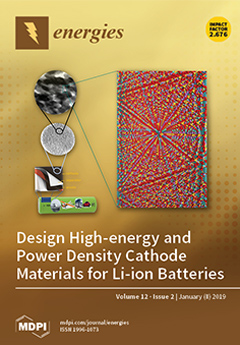This paper proposes a strategy for sizing a battery energy storage system (
BESS) that supports primary frequency regulation (
PFR) service of solar photo-voltaic plants. The strategy is composed of an optimization model and a performance assessment algorithm. The optimization
[...] Read more.
This paper proposes a strategy for sizing a battery energy storage system (
BESS) that supports primary frequency regulation (
PFR) service of solar photo-voltaic plants. The strategy is composed of an optimization model and a performance assessment algorithm. The optimization model includes not only investment costs, but also a novel penalty function depending on the state of charge (
SoC). This function avoids the existence of a potential inappropriate
SoC trajectory during
BESS operation that could impede the supply of
PFR service. The performance assessment algorithm, fed by the optimization model sizing results, allows the emulation of
BESS operation and determines either the success or failure of a particular
BESS design. The quality of a
BESS design is measured through number of days in which
BESS failed to satisfactorily provide
PFR and its associated penalization cost. Battery lifetime, battery replacements, and
SoC are also key performance indexes that finally permit making better decisions in the election of the best
BESS size. The inclusion of multiple
BESS operational restrictions under
PFR is another important advantage of this strategy since it adds a realistic characterization of
BESS to the analysis. The optimization model was coded using GAMS/CPLEX, and the performance assessment algorithm was implemented in MATLAB. Results were obtained using actual frequency data obtained from the Colombian power system; and the resulting
BESS sizes show that the number of
BESS penalties, caused by failure to provide
PFR service, can be reduced to zero at minimum investment cost.
Full article





